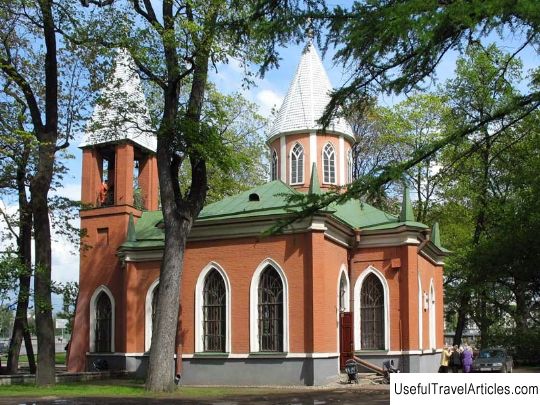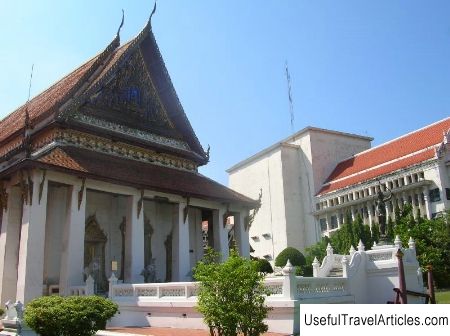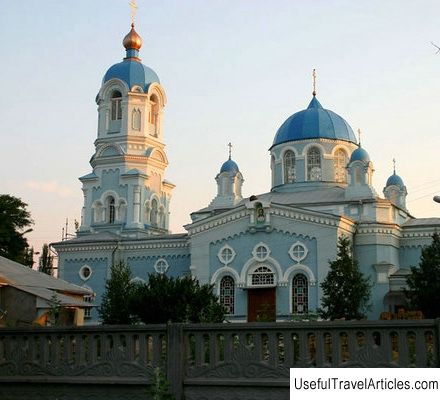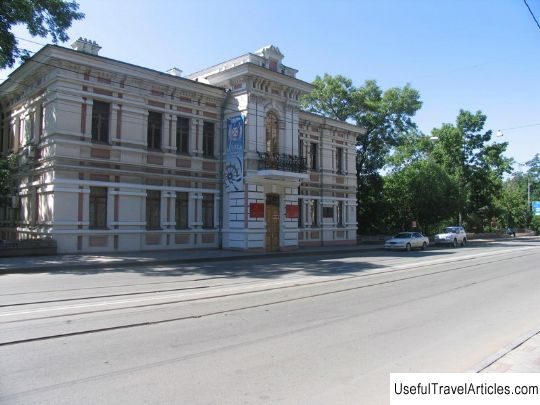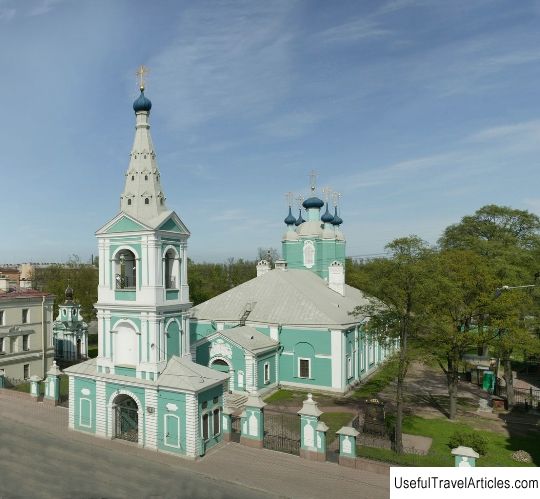Chesme Church description and photo - Russia - St. Petersburg: St. Petersburg
Rating: 8,0/10 (549 votes) 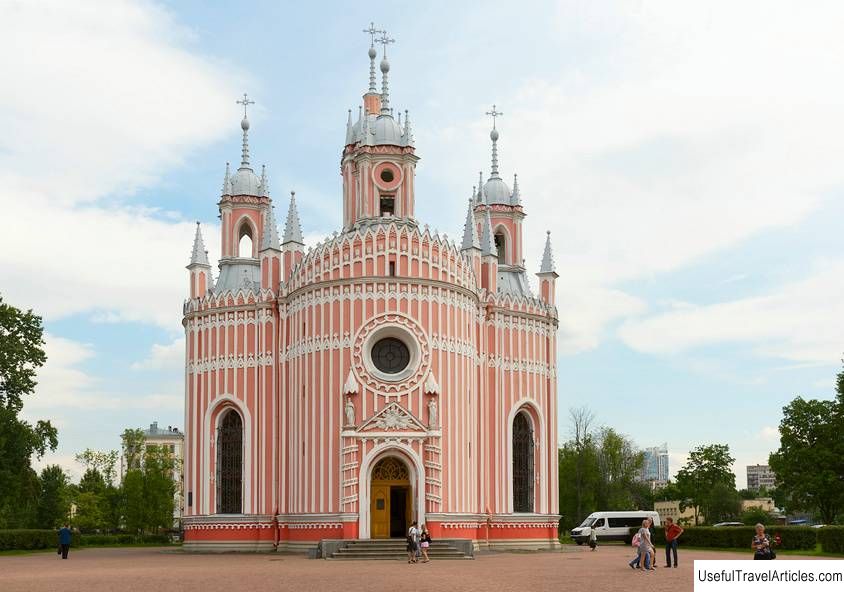
Chesme Church description and photos - Russia - Saint Petersburg: Saint Petersburg. Detailed information about the attraction. Description, photos and a map showing the nearest significant objects. Photo and descriptionOne of the architectural monuments of the 18th century that adorn the northern Russian capital and form its unique appearance is the Chesme Church (or, more precisely, Church of the Nativity of John the Baptist - so its official name sounds). The temple was built in memory of one of the battles of the Russian-Turkish war, which took place near Anatolia and the island of Chios, namely in Chesme Bay . In this battle, the Turkish fleet was defeated. Once the temple was a single architectural ensemble with the nearby imperial traveling palace . Currently, this architectural unity between them has been lost. There is also a cemetery (military) near the church. The temple is operational. The building was built in accordance with the canons of pseudo-Gothic . This style is also known as Russian or False Gothic. The history of the templeThere is a legend about the choice of a place for the construction of the temple: according to the legend, it was at the place where the church was later erected that Catherine II received a message about the defeat of the Turks. But there is no evidence of the reliability of this story. Construction of the temple began in the second half of the 70s of the 18th century. The laying of the building took place in a solemn atmosphere; the Russian empress and the king of Sweden were present. The building was designed by Yuri Felten . The consecration of the church took place in the early 80s of the 18th century . This ceremony was again attended by the Empress. The ruler of the Holy Roman Empire was also invited (he attended the consecration of the temple incognito). Subsequently, the empress often attended services in the new church. It even had a special place that she occupied during her visits. This place could not be occupied by anyone else. The temple was summer (that is, it was not heated). In this regard, a winter church was consecrated in a palace located not far from the temple. Soon after the revolutionary events of the early 20th century, it was closed . For some time, parishioners and priests used another building (services were held at the dacha of one of the townspeople), but in the mid-1920s, they lost this opportunity as well. In the post-revolutionary period, the temple ended up on the territory of the camp, where those sentenced to forced labor were serving their sentences . At that time, the building lost its bells. The cross was replaced with new images: now the dome was crowned with an anvil, a hammer and pincers. In the mid-1920s, the camp was closed. For some time, the building was used to store various archives, then it housed several carpentry workshops . In the early 30s, a terrible fire broke out in the building of the former temple. The interiors were completely destroyed (in particular, the old iconostasis burned down). In the 40s of the XX century, the building was badly damaged as a result of military actions . Restoration work in it began only in the 60s. The restorers had to work hard to restore the architectural appearance of the church. Its domes were repaired, the brickwork was strengthened, and a number of lost elements were restored. The interiors were restored (damaged in the pre-war period), new bells were cast. In the late 70s of the XX century (that is, almost two centuries after the foundation of the temple), a museum was opened in the building. In it one could see an exposition dedicated to the victory in the Chesme Bay. In the early 90s, divine services were resumed in the church . A few years later, the old iconostasis was restored, destroyed by fire in the 30s of the XX century. To restore it, drawings were used, which were found in one of the Russian archives. In the late 90s of the XX century, the iconostasis was consecrated. This ceremony was conducted by Metropolitan Vladimir . Temple architecture and decoration Let's take a closer look at some of the architectural features of the building and elements of the decoration of the temple: - The building plan is compact," centric ": the temple is built in the form of a "four-leafed" (or Greek equal-pointed cross). The basis of the church space is a square, it is covered by a dome. Four apses adjoin this room. They are connected to the main room by four pointed arches. The windows in the temple are also lancet, high. - The walls of the temple are decorated with an openwork white stone ornament . Notice also the bas-relief depicting the eye of God and the cherubim. It is placed on the pediment. The striking features of the architectural appearance of the building are the jagged parapet and pointed turrets . Once there was a clock in one of the turrets. - Five small domes are crowned with miniature spiers. On each of the spiers there is a openwork cross . All these crosses are distinguished by their lightness and grace. bells are placed under the heads of the temple. - There are two sculptures near the entrance to the building. One of them symbolizes Faith (the one that holds the cup and cross in her hands), and the second - Hope (the one that is decorated with a palm branch and a stylized flame). - The distinctive features of the interior decoration of the church are simplicity and severity. The Iconostasis , which you will see in the temple, is a restored copy of the old iconostasis, made according to the drawings of the famous architect in the 18th century. This iconostasis, painted white (a symbol of heavenly purity), is decorated with gilded carvings. Sculptural images of saints rise above it, they are also covered with gilding. Before the temple was closed, there were several images created by Italian masters in it. Two of these icons were images of episodes from the life of Christ, on the third one could see a battle scene (the famous Chesme battle), another depicted Tsarevich Dmitry. Today, they have been replaced by images made by contemporary artists, who carefully followed the old canons of Italian painting. Pay attention to the marble board installed at the entrance to the temple. The inscription on it is actually a summary of the history of the building (the year of the foundation of the temple, the year of its consecration, etc.). Duplicate copies In the 18th century two churches were built, which are copies of the Chesme temple . One of them has survived to this day - this is the Transfiguration Church , built in the 90s of the 18th century. It was erected in one of the villages not far from Tver, on an estate that belonged to the opera singer. White stone was used in its construction, mined in local quarries. It should be noted that this building is still slightly different from the famous St. Petersburg church. In particular, the sculptures, which are symbols of Faith and Hope, have been replaced here with figures of angels. The second temple, built in the 80s of the 18th century, has not survived to this day. He was in the estate owned by Lieutenant General Alexander Lanskoy , the Empress's favorite. He was present at the laying of the famous St. Petersburg church; perhaps it was then that he came up with the idea to build a copy of this building on his estate. However, the temple, built by the favorite of Catherine II, was still not an exact copy of the famous church: the lieutenant general added a bell tower, which, according to the surviving documents, was quite high. After the death of the owner of the estate, the church he built was used very rarely, gradually it fell into disrepair. Already in the 19th century, local residents believed that the building needed to be dismantled. The peasants set up hives in its turrets. In the 1920s, the building was dismantled. The cemetery at the templeSeparately, a few words should be said about the cemetery located at the famous temple. It has existed since the mid-30s of the XIX century (that is, much younger than the temple). The cemetery is rectangular in shape. Here you can see the graves of veterans who took part in the campaigns of Alexander Suvorov. Those who fought with Napoleon's army in 1812 are buried here, next to them are the graves of the soldiers who took part in the defense of Sevastopol (in the 50s of the XIX century), in the Russian-Turkish and Russian-Japanese wars. Here lie the soldiers who died on the battlefields of the First World War. In the cemetery at the temple are buried the Red Army soldiers (who died in battles in the early years of Soviet power) and the defenders of Leningrad (who defended it from the Nazi invaders in the 40s of the XX century). In the mid 60s of the XX century it existed the project of reorganization of the territory near the temple, including the cemetery. It was planned to enclose the area near the church with an anchor chain; this area was also supposed to be surrounded by birches. The installation of ancient anchors and cannons was planned on the square. Obelisks were to be installed at the cemetery. For a number of reasons, this project was never implemented. At the beginning of the 21st century, a monument to all fallen Russian soldiers was erected at the entrance to the cemetery. The monument is a cross with a plaque at the base. Around the same period of time, during the construction of one of the city shops, the remains of several defenders of Leningrad were discovered. They were solemnly buried at the military cemetery (in its left corner, closest to the entrance). Notes
         We also recommend reading Shah's palace description and photo - Ukraine: Odessa Topic: Chesme Church description and photo - Russia - St. Petersburg: St. Petersburg. |
